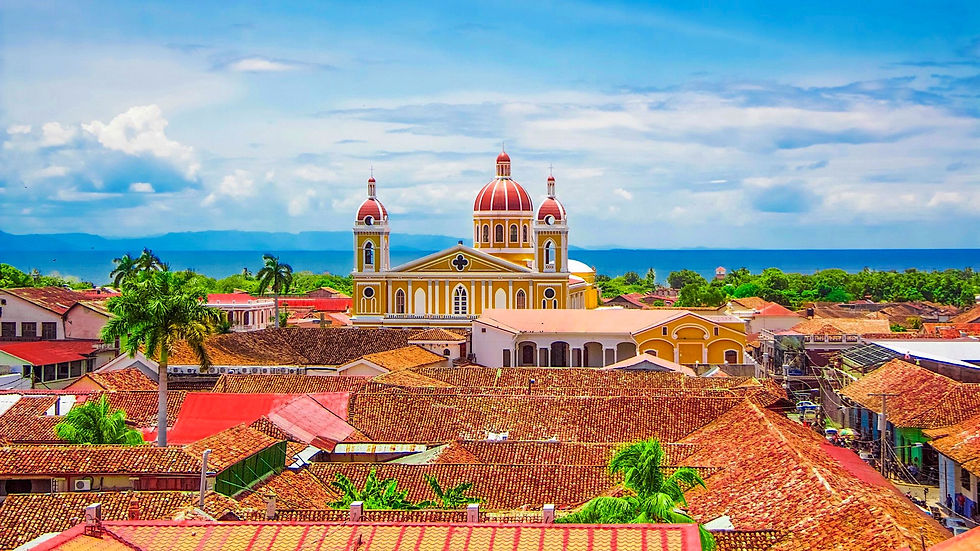
Nicaragua is an emerging gem in Central America, offering rich cultural heritage, diverse landscapes, and unique adventure opportunities for travellers seeking authentic experiences.
From colonial cities like Granada and León to pristine beaches, volcanic landscapes, and lush rainforests, the country provides a broad range of itinerary options that appeal to adventure seekers, cultural enthusiasts, and nature lovers alike.
But before taking a trip, what key details should your clients know?
Here’s some useful information about visiting Nicaragua.
Population
Nicaragua is home to approximately 6.15 million people, with most of the population concentrated in the western regions. The majority identify as mestizo (a mix of European and indigenous ancestry), while smaller communities of Afro-Caribbeans, indigenous groups, and European descendants add to the country’s rich cultural diversity.
Language
Spanish is the official language and is spoken by most Nicaraguans. However, English and indigenous languages are commonly used along the Caribbean coast. While many locals in tourist areas speak some English, learning a few Spanish phrases can be helpful:
Hola – Hello
Gracias – Thank you
¿Cuánto cuesta? – How much does it cost?
¿Dónde está…? – Where is…?
La cuenta, por favor – The bill, please
¡Qué tuani! – How cool! (Nicaraguan slang)
Climate
Nicaragua has a tropical climate, making it warm and humid year-round, but the weather varies by region and season. Here's what to expect generally:
Dry Season (November – April): This is the best time to visit for sunny, warm days and little to no rain
Rainy Season (May – October): Visitors can expect some afternoon showers, especially on the Caribbean coast. The Pacific side sees more sporadic rain
July to August (short dry spell called "veranillo" in the rainy season).
However there are some regional differences to be aware of:
Pacific Coast & Cities (Leon, Managua, Granada, Rivas, San Juan del Sur)
Warm year-round (27–35°C).
The dry season is hot and sunny; the rainy season brings occasional showers but still warm
Central Highlands (Matagalpa, Estelí, Jinotega, Somoto and Nueva Segovia)
This area is cooler than the lowlands, especially at night (16–27°C)
The rainy season brings lush green landscapes
Caribbean Coast (Rio San Jan, Bluefields, Laguna de Perlas, Corn Islands)
Humid most of the year
The best months to visit are February to April and mid-July to mid-September when there is less rainfall
Airports & entry requirements
The main international gateway to Nicaragua is Augusto C. Sandino International Airport in Managua, while domestic travel is supported by airports in Bluefields, Bilwi, Corn Island, San Carlos, Ometepe, and Costa Esmeralda.
To enter Nicaragua, travellers need:
✅ A passport valid for at least six months
✅ A Tourist Card ($10 USD), payable in cash (only in US dollars or Córdobas) upon arrival.
✅ A Migration fee at the land borders ($3 USD) and a Municipality fee ($1USD) payable in cash (only in US dollars or Córdobas) upon arrival
Getting Around
Taxis are widely available and affordable. We recommend always using official taxis with red license plates or radio-dispatched taxis from hotels.
Major car rental companies operate in Managua and at the airport. A valid foreign driver’s license can be used for up to 30 days.
Inter-city buses are a budget-friendly way to travel, but schedules can be unpredictable.
In cities like León and Granada, walking is the best way to explore, thanks to their compact and pedestrian-friendly streets.
Currency
The official currency is the Córdoba (C$), but US dollars are widely accepted in hotels, restaurants, and shops. Major credit cards are accepted in urban and tourist areas, though it’s good to carry cash for smaller vendors, markets and tips.
Currency exchange can be done at banks and hotels. The official exchange rate is: C$36.6243 per US dollar
Tipping
For airport/hotel baggage handlers, US $2.00 per bag is acceptable. For restaurants and other services, 10-15% of the bill is customary, but not obligatory.
Electrical Outlets & Plugs
Nicaragua uses Type A and B plugs, the same as in the United States and Canada. The standard voltage is 120V with a frequency of 60Hz. If travelling from Europe or other regions that use different plugs, you may need an adapter and possibly a voltage converter for your devices.
Cuisine
Nicaraguan cuisine is a flavourful blend of indigenous, Spanish, and Creole influences. Expect hearty meals featuring rice, beans, plantains, fresh seafood, and locally grown vegetables. Popular dishes include Gallo Pinto (rice and beans), Indio Viejo (a traditional stew), and Nacatamales (Nicaraguan-style tamales). Vegetarians will find options like quesillo(cheese-filled tortillas) and fresh tropical fruits, though choices may be more limited in remote areas. With Solentiname Tours, discover delicious upscale fusion cuisine, excellent grass-fed meat, local fish dishes, and vegan plates.
Safety
Nicaragua is considered one of the safest countries in Central America for visitors (according to data supplied by Interpol and the UN). Areas such as Granada, León, San Juan del Sur, Solentiname and Ometepe are tourist friendly and the cities are well policed. However, like any destination, it’s important to take basic precautions; avoid displaying valuables, use a reputable tour company, and stay informed about local conditions.
Family-Friendly Destination
Nicaragua is an excellent destination for families, offering a mix of adventure, culture, and relaxation. Kids will love exploring volcanoes, spotting wildlife in nature reserves, and enjoying the beautiful Pacific and Caribbean beaches. Many hotels and lodges are family-friendly, and guided tours can be tailored for children. However, some remote areas may have limited facilities, so planning ahead is recommended.
The top activities for travellers
Nicaragua is a haven for nature lovers and outdoor enthusiasts. There are a variety of experiences to try, suitable for all abilities. Using our extensive regional knowledge, we expertly create tailored FIT and group itineraries to suit a wide range of travellers. We combine well known sights, hidden secrets, and local encounters that connect visitors with the heart and soul of Nicaragua.
You can see our top ten recommendations here!
.png)
Comentários